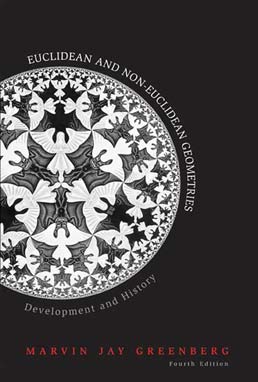
GET FREE SHIPPING!
Use Promo Code SHIPFREE at Step 4 of checkout.
*Free Shipping only applicable to US orders. Restrictions apply.
ISBN:9781429281331
Take notes, add highlights, and download our mobile-friendly e-books.
ISBN:9780716799481
Read and study old-school with our bound texts.
This is the definitive presentation of the history, development and philosophical significance of non-Euclidean geometry as well as of the rigorous foundations for it and for elementary Euclidean geometry, essentially according to Hilbert. Appropriate for liberal arts students, prospective high school teachers, math. majors, and even bright high school students. The first eight chapters are mostly accessible to any educated reader; the last two chapters and the two appendices contain more advanced material, such as the classification of motions, hyperbolic trigonometry, hyperbolic constructions, classification of Hilbert planes and an introduction to Riemannian geometry.
E-book
Read online (or offline) with all the highlighting and notetaking tools you need to be successful in this course.
Learn MoreTable of Contents
Chapter 1 Euclid’s Geometry
Very Brief Survey of the Beginnings of Geometry
The Pythagoreans
Plato
Euclid of Alexandria
The Axiomatic Method
Undefined Terms
Euclid’s First Four Postulates
The Parallel Postulate
Attempts to Prove the Parallel Postulate
The Danger in Diagrams
The Power of Diagrams
Straightedge-and-Compass Constructions, Briefly
Descartes’ Analytic Geometry and Broader Idea of Constructions
Briefly on the Number ð
Conclusion
Chapter 2 Logic and Incidence Geometry
Elementary Logic
Theorems and Proofs
RAA Proofs
Negation
Quantifiers
Implication
Law of Excluded Middle and Proof by Cases
Brief Historical Remarks
Incidence Geometry
Models
Consistency
Isomorphism of Models
Projective and Affine Planes
Brief History of Real Projective Geometry
Conclusion
Chapter 3 Hilbert’s Axioms
Flaws in Euclid
Axioms of Betweenness
Axioms of Congruence
Axioms of Continuity
Hilbert’s Euclidean Axiom of Parallelism
Conclusion
Chapter 4 Neutral Geometry
Geometry without a Parallel Axiom
Alternate Interior Angle Theorem
Exterior Angle Theorem
Measure of Angles and Segments
Equivalence of Euclidean Parallel Postulates
Saccheri and Lambert Quadrilaterals
Angle Sum of a Triangle
Conclusion
Chapter 5 History of the Parallel Postulate
Review
Proclus
Equidistance
Wallis
Saccheri
Clairaut’s Axiom and Proclus’ Theorem
Legendre
Lambert and Taurinus
Farkas Bolyai
Chapter 6 The Discovery of Non-Euclidean Geometry
János Bolyai
Gauss
Lobachevsky
Subsequent Developments
Non-Euclidean Hilbert Planes
The Defect
Similar Triangles
Parallels Which Admit a Common Perpendicular
Limiting Parallel Rays, Hyperbolic Planes
Classification of Parallels
Strange New Universe?
Chapter 7 Independence of the Parallel Postulate
Consistency of Hyperbolic Geometry
Beltrami’s Interpretation
The Beltrami–Klein Model
The Poincaré Models
Perpendicularity in the Beltrami–Klein Model
A Model of the Hyperbolic Plane from Physics
Inversion in Circles, Poincaré Congruence
The Projective Nature of the Beltrami–Klein Model
Conclusion
Chapter 8 Philosophical Implications, Fruitful Applications
What Is the Geometry of Physical Space?
What Is Mathematics About?
The Controversy about the Foundations of Mathematics
The Meaning
The Fruitfulness of Hyperbolic Geometry for Other Branches of Mathematics, Cosmology, and Art
Chapter 9 Geometric Transformations
Klein’s Erlanger Programme
Groups
Applications to Geometric Problems
Motions and Similarities
Reflections
Rotations
Translations
Half-Turns
Ideal Points in the Hyperbolic Plane
Parallel Displacements
Glides
Classification of Motions
Automorphisms of the Cartesian Model
Motions in the Poincaré Model
Congruence Described by Motions
Symmetry
Chapter 10 Further Results in Real Hyperbolic Geometry
Area and Defect
The Angle of Parallelism
Cycles
The Curvature of the Hyperbolic Plane
Hyperbolic Trigonometry
Circumference and Area of a Circle
Saccheri and Lambert Quadrilaterals
Coordinates in the Real Hyperbolic Plane
The Circumscribed Cycle of a Triangle
Bolyai’s Constructions in the Hyperbolic Plane
Appendix A
Appendix B
Axioms
Bibliography
Symbols
Name Index
Subject Index
 Canada
Canada



